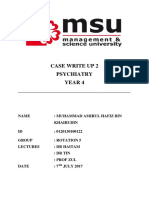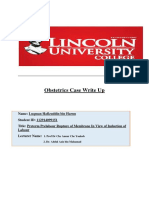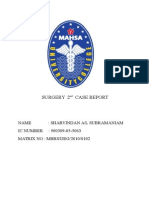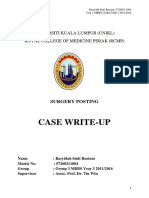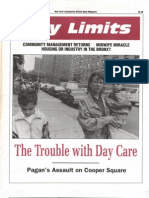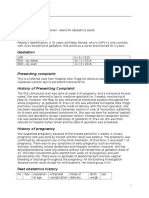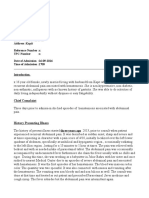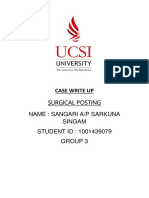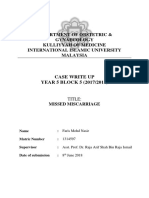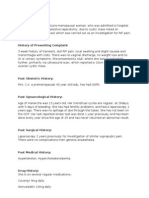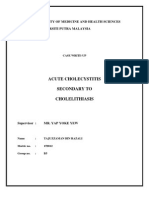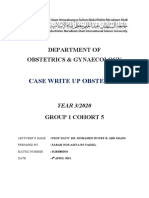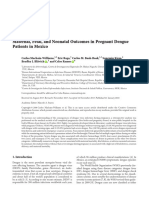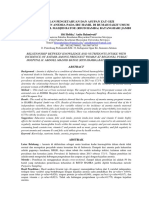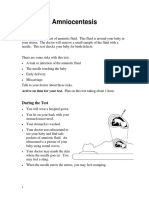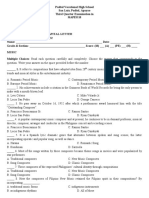Professional Documents
Culture Documents
Case Write Up
Case Write Up
Uploaded by
Aisyah HamdanOriginal Description:
Original Title
Copyright
Available Formats
Share this document
Did you find this document useful?
Is this content inappropriate?
Report this DocumentCopyright:
Available Formats
Case Write Up
Case Write Up
Uploaded by
Aisyah HamdanCopyright:
Available Formats
OBSTETRIC AND GYNEACOLOGY
Year 5, MBBS 08/09
CASE WRITE-UP
MACROSOMIA
Name: Mohamad Aizuddin bin Ahmad Matric No.: 0808-0811 Group/ Rotation: 01/5 Supervisor: Assoc.
Prof. Dr. Mohd Haizal Mohd Nor
PATIENTS HISTORY History Madam NH, 34 year old malay lady from Putrajaya G4P3 at 38 period of gestation was admitted yesterday for elective lower segment caeserian section secondary to macrosomic baby. Her LNMP was 3/4/12 and her EDD is 10/1/13. Patient detect the pregnancy when she missed period for 2 months. Then she confirmed the pregnancy in private clinic by urine pregnancy test. Booking was done at 12 week of pregnancy in KK Putrajaya. During booking fasting blood glucose is 5.6, BP 92/72, weight is 123kg, height 140cm, HB 12.5, blood test for infectious disease was non reactive, and maternal blood group is O+. 3 scans was done throughout the pregnancy, 1st scan at 16 weeks which reveal normal size fetus and normal amount of liquor, but during 2nd scan which at 28 weeks, fetus was detected to be larger than dates and the latest scan which at 36 weeks of pregnancy show a big fetus estimated weight of 4.4kg. Throughout the pregnancy maternal blood was well controlled which 1 set of blood sugar profile was done at 28 week and the result was normal which the reading is 6, 4.7, 4.3, 4. Throughout the pregnancy maternal weight gain is 13kg besides of maternal is obese with BMI of 35. Previous pregnancy patient was blessed with 3 children which all of them are boys, delivered in 2001, 2004 and 2010 and was delivered uneventful via spontaneous vaginal delivery and was breastfeed up to 6 month. The weight of the baby is 3.7kg, 3.4kg and 3.1kg. During the 3rd or previous pregnancy patient was diagnosed with gestational diabetes mellitus on insulin and was induced at 38 weeks. Both patients parent has type 2 diabetes mellitus. Beside that, no other significant history.
PHYSICAL EXAMINATION On inspection, patient lying supine, alert but uncomfortable with overdistended abdomen, pulse rate 78 beats per minute, with regular rhythm and good volume, bp 114/75, patient is not pale, no sign of dehydration. Her abdomen was distended with gravid uterus as evidence by linea nigra and striae gravidarum. Umbilical is everted, no skin changes, no dilated but there are visible vein. On palpation, abdomen was soft and non tender. Symphysis fundal height was 40 cm which is larger than dates, baby singleton, with fetal back on the right side of maternal, oblique lie with head at left iliac fossa.
PROVISIONAL DIAGNOSIS
Elective lower segment caeserian section secondary to macrosomic baby.
DISCUSSION Risk of macrosomic baby in this patient Fetal macrosomia is defined when the fetal weight is more than 4kg or greater than 90% of gestational age. The delivery of a macrosomic fetus (defined as a birth weight of at least 4000 g) is associated with prolonged labor, an increased likelihood of operative delivery. The pathophysiology of macrosomic baby is, poorly controlled macrosomia and have intermittent periods of hyperglycemia in common. Hyperglycemia in the fetus results in the stimulation of insulin, insulinlike growth factors, growth hormone, and other growth factors, which, in turn, stimulate fetal growth and deposition of fat and glycogen. It is very important to anticipate macrosomic fetus for proper and safe delivery. It is very important to know patient that at risk to develop macrosomic baby. If we can prevent maternal to develop macrosomic baby, then we can prevent more co-morbid to maternal and especially to fetus in this case. Although the causes of high birthweight include both genetic and environmental factors, the rapid increase in the maternal overweight and associated metabolic changes, including type 2 and gestational diabetes, play a central role. Other study stated that, Fasting plasma glucose at week 3032, but not fasting plasma insulin or insulin resistance, is a determinant of newborn macrosomia. Overweight women with high increase in fasting plasma glucose from early to late pregnancy had a 4.5-fold increase in risk of newborn macrosomia compared to the remaining group with high BMI. Among the risk factors to develop macrosomic baby that is related to this patient is maternal overweight, patient gestational diabetes, type 2 diabetes mellitus, and previous macrosomic baby. Neonatal birth weight and the incidence of macrosomia were similar in comparison of pregnancies with and without GDM. In the population of Caucasian women the strongest single predictors for macrosomia were prior macrosomia, BMI>23kg/m(2) and prior GDM. According to this study, the three most important predictor of macrosomic baby is prior macrosomia, maternal BMI more than 23 and prior gestational diabetes mellitus. Even the latest study state that they can predict the sex depending on oral glucose tolerance test. There is sexual dimorphism in the risk of abnormal birth weight attributed to maternal glucose tolerance status. A closer surveillance of foetal growth might be warranted in pregnant women with abnormal glucose tolerance carrying a male fetus. There are many study done show the risk of future macrosomic baby according to certain features and certain investigation. Given the complications that are associated with delivering large babies, overweight women may benefit from not gaining excess weight gain in pregnancy, The corrected weight gain is a better estimate of true accretion of maternal weight. Our results suggest that recommendations for weight gain during pregnancy should take this index into account, There is no difference in accuracy
between ultrasonographically EFW and AC in the prediction of a macrosomic baby at birth. A positive test result is more accurate for ruling in macrosomia than a negative test result for ruling it out, There is a significant correlation between mid-third-trimester AFI and BW. AFI > or = 60th percentile and EFW > or = 71st percentile during the mid third trimester are useful predictors of severe macrosomia at birth
Complication in macrosomic baby.
When we encounter patient that has high risk or patient that alredy diagnose as macrosomic baby must take precaution especially in the rule of choosing methods of delivery. There are many complication of macrosomic baby. Gestational diabetes, maternal obesity, increasing age and parity were the main risk factors for fetal macrosomia. The incidence of shoulder dystocia, birth injuries and neonatal morbidity increased in this group. The larger the baby or fetus the higher complication might occur. Birth weight greater than 4500 g, and especially greater than 5000 g, is associated with increased risks of perinatal and infant mortality and morbidity. With multiple complication, patient also can encounter these dangerous condition in the next pregnancy. Women with a history of one macrosomic infant are at significantly increased risk of another macrosomic infant in a subsequent pregnancy. We know that that there are many complication especially to the fetus if the development of macrosomic baby occur. Therefore, proper evaluation and monitoring need to be done in this patient and the fetus. Macrosomia was associated with an increased risk of adverse maternal and neonatal health outcomes. Optimal management strategies of macrosomic pregnancies need evaluation. Lastly, patient need to go into delivery if the already reach the exact time. Before choosing the types of delivery we need to assess maternal and fetus condition if they fit for vaginal delivery. Macrosomia was associated with increased rates of instrumental delivery and anal sphincter injury regardless of parity, and additionally with increased rates of caesarean delivery and shoulder dystocia among nulliparas. Overall, 88% of women who laboured with a macrosomic infant achieved vaginal delivery.
References
BMJ Bestpractice Acta Obstetricia et Gynecologica Scandinavi, Volume 87, Issue 2, pages 134 145, February 2008 Suneet P. Chauhan, MD,Suspicion and treatment of the macrosomic fetus: A review, American Journal of Obstetrics and Gynecology (2005) 193, 33246 Nanna voldner et.al, Increased risk of macrosomia among overweight women with high gestational rise in fasting glucose, January 2010, Vol. 23, No. 1 Ogonowski J, Factors influencing risk of macrosomia in women with gestational diabetes mellitus undergoing intensive diabetic care, Diabetes Res Clin Pract. 2008 Jun;80(3):405-10. doi: 10.1016/j.diabres.2008.01.017. Epub 2008 Mar 14.
W. Ricart, Maternal glucose tolerance status influences the risk of macrosomia in male but not in female foetuses, J Epidemiol Community Health 2009;63:64-68 doi:10.1136/jech.2008.074542
PREPREGNANT BODY MASS INDEX, WEIGHT GAIN AND THE RISK OF DELIVERING LARGE BABIES AMONG NON-DIABETIC MOTHERS, Int J Gynaecol Obstet. 2007 May; 97 100104.
Fetal macrosomia and maternal weight gain during pregnancy Doi : DM-092002-28-4-1262-3636-101019-ART9
Accuracy of ultrasound biometry in the prediction of macrosomia: a systematic quantitative review, BJOG: An International Journal of Obstetrics & Gynaecology Volume 112, Issue 11 pages 14611466, November 2005 How big is too big? The perinatal consequences of fetal macrosomia, American Journal of Obstetrics & Gynecology Volume 198, Issue 5, Pages 517.e1-517.e6, May 2008 Fetal macrosomia. Risk factor and outcome. Saudi Medical Journal [2005, 26(1):96-100]
You might also like
- Chapter 24 Prep UDocument9 pagesChapter 24 Prep UMary Ann CarandangNo ratings yet
- O&g Case Write UpDocument17 pagesO&g Case Write Upmohd faizhakimNo ratings yet
- Fibroid Case Write Up - GynaecologyDocument23 pagesFibroid Case Write Up - GynaecologySarwhin Sugumaran100% (2)
- Case Write Up SURGERYDocument14 pagesCase Write Up SURGERYRahul Audenesen50% (2)
- Case Write Up 2Document16 pagesCase Write Up 2Amirul Hafiz100% (3)
- Paeds Case Write Up 1Document29 pagesPaeds Case Write Up 1Charlotte Ee33% (3)
- Case Write Up (Peadiatrics) SangariDocument11 pagesCase Write Up (Peadiatrics) SangariAmbhi GanaNo ratings yet
- Case Report Example - GynaecologyDocument14 pagesCase Report Example - GynaecologyDr Onn Azli PuadeNo ratings yet
- Cwu Breast AbscessDocument10 pagesCwu Breast AbscessfarahmazlanNo ratings yet
- Obstetrics and Gynaecology Write Up 3Document10 pagesObstetrics and Gynaecology Write Up 3Luqman HarunNo ratings yet
- Appendicitis Case Write UpDocument5 pagesAppendicitis Case Write UpKaarthigan Ramaiah100% (1)
- Case Write Up SurgeryDocument13 pagesCase Write Up SurgerySharvin100% (3)
- Case Write Up Acute PancreatitisDocument25 pagesCase Write Up Acute PancreatitislunaNo ratings yet
- Case Write UpDocument15 pagesCase Write UpAmirul Hafiz100% (1)
- Case Write Up - Harmeet - Multinodular GoitreDocument29 pagesCase Write Up - Harmeet - Multinodular GoitreShalini Soorya71% (7)
- Case Write Up-DengueDocument16 pagesCase Write Up-DengueSyafi'ie Syukri100% (1)
- Case Write Up - Dengue FeverDocument22 pagesCase Write Up - Dengue FevervijayaNo ratings yet
- Surgery Case Write UpDocument8 pagesSurgery Case Write UpKaarthigan RamaiahNo ratings yet
- Ultrasound Features in Early PregnancyDocument10 pagesUltrasound Features in Early Pregnancymadimadi11No ratings yet
- City Limits Magazine, June/July Issue 1993Document32 pagesCity Limits Magazine, June/July Issue 1993City Limits (New York)No ratings yet
- WH Case Write Up OBSDocument5 pagesWH Case Write Up OBSJiaYee GoNo ratings yet
- Case Write-Up - Obstetrics - Gestational Diabetes MellitusDocument17 pagesCase Write-Up - Obstetrics - Gestational Diabetes MellitusHakimah K. Suhaimi89% (38)
- Cwu O&g 1 PPROMDocument13 pagesCwu O&g 1 PPROMFaris Mohd Nasir100% (1)
- Gynaecology Threatened Miscarriage Case WriteupDocument10 pagesGynaecology Threatened Miscarriage Case WriteupGayathrie Mahalingam100% (1)
- Surgery Case Write Up UGIHDocument37 pagesSurgery Case Write Up UGIHRahul Audenesen33% (3)
- Case Write Up 1 ANCDocument5 pagesCase Write Up 1 ANCfafa dejanNo ratings yet
- Case Write Up Obstetrics Gestational Diabetes MellitusDocument13 pagesCase Write Up Obstetrics Gestational Diabetes MellitusRoshandiep GillNo ratings yet
- Year 5 Obs CWUDocument12 pagesYear 5 Obs CWUEidi IdhamNo ratings yet
- Cwu Ong Year 5Document23 pagesCwu Ong Year 5Nurulasyikin MAANo ratings yet
- Gynaecology Case 2Document6 pagesGynaecology Case 2Francesca AkanjiNo ratings yet
- CASE WRITE UP-obstetric CaseDocument7 pagesCASE WRITE UP-obstetric CaseAmbhi GanaNo ratings yet
- Bronchial Asthma Case Write UpDocument5 pagesBronchial Asthma Case Write UpEry FarishNo ratings yet
- Case Write UpsDocument4 pagesCase Write UpsMuhammad AzmanNo ratings yet
- Case Write Up FibroidDocument17 pagesCase Write Up FibroidNadsri AmirNo ratings yet
- Pediatrics CWU Year 5Document7 pagesPediatrics CWU Year 5anon_67984147No ratings yet
- Case Write Up 1-CholecystitisDocument9 pagesCase Write Up 1-CholecystitisAmbhi Gana100% (1)
- Case Write UpDocument9 pagesCase Write UpAbdulaziz Al-eisa33% (3)
- Case Write Up 2Document16 pagesCase Write Up 2Shidev100% (1)
- Breast CarcinomaDocument13 pagesBreast Carcinomamegat120288100% (1)
- HTN Complicating PregnancyDocument18 pagesHTN Complicating PregnancyAiman ArifinNo ratings yet
- GDM 3Document12 pagesGDM 3Aiman ArifinNo ratings yet
- Write Up Surgery 1 TambahDocument22 pagesWrite Up Surgery 1 Tambahazizi abd rahmanNo ratings yet
- Ong Case Sheet Sem7Document13 pagesOng Case Sheet Sem7Uchiha AnzarNo ratings yet
- Long Case O&G-placenta PraeviaDocument24 pagesLong Case O&G-placenta Praeviasaifulhusni100% (2)
- Case Study GDM Complete 2017Document34 pagesCase Study GDM Complete 2017GANESANNo ratings yet
- CWU 2 Epipepsy - West SyndromeDocument10 pagesCWU 2 Epipepsy - West SyndromeZul Hisyam Fikri100% (1)
- Case Write Up 1: Dengue Haemorrhagic Fever Saarah Huurieyah BT Wan Rosli 1050024 Year 4 Internal MedicineDocument16 pagesCase Write Up 1: Dengue Haemorrhagic Fever Saarah Huurieyah BT Wan Rosli 1050024 Year 4 Internal MedicineRoshandiep GillNo ratings yet
- GDM Case PresentationDocument20 pagesGDM Case PresentationATEHAN BORDS100% (1)
- Cwu SurgeryDocument16 pagesCwu SurgeryAslah NabilahNo ratings yet
- Clerking An o & G CaseDocument57 pagesClerking An o & G CaseAlan Na100% (2)
- CWU Gynae Missed MiscarriageDocument8 pagesCWU Gynae Missed MiscarriageFaris Mohd NasirNo ratings yet
- Gestational Diabetes MellitusDocument11 pagesGestational Diabetes Mellitusjohn jumborock100% (1)
- Case Summary Ovarian CystDocument4 pagesCase Summary Ovarian CystFrancesca AkanjiNo ratings yet
- HSP Case Presentation PDFDocument71 pagesHSP Case Presentation PDFJoan Luis100% (1)
- Cwe Nephrotic SnydromeDocument15 pagesCwe Nephrotic SnydromeFariezuan Hamid100% (1)
- Y3 T2 PAM CWU 2 - Acute BronchiolitisDocument7 pagesY3 T2 PAM CWU 2 - Acute Bronchiolitisanon_67984147No ratings yet
- Case Write-Up 1Document16 pagesCase Write-Up 1Zharif Fikri100% (3)
- CWU MedicineDocument37 pagesCWU MedicineAzizi Abd RahmanNo ratings yet
- Preterm ContractionDocument19 pagesPreterm ContractionAiman ArifinNo ratings yet
- Farah Cwu Obstetric EditDocument19 pagesFarah Cwu Obstetric EditfarahNo ratings yet
- Implications of Early Pregnancy Obesity On Maternal, Fetal and Neonatal Health PDFDocument7 pagesImplications of Early Pregnancy Obesity On Maternal, Fetal and Neonatal Health PDFAndhika Dimas ANo ratings yet
- Fetal Macrosomia : Its Maternal and Neonatal ComplicationsDocument6 pagesFetal Macrosomia : Its Maternal and Neonatal ComplicationsTheresia Herestuwito NaruNo ratings yet
- J of Obstet and Gynaecol - 2012 - Aksornphusitaphong - Risk Factors of Early and Late Onset Pre EclampsiaDocument5 pagesJ of Obstet and Gynaecol - 2012 - Aksornphusitaphong - Risk Factors of Early and Late Onset Pre EclampsiaDefi SelvianitaNo ratings yet
- Prelegere RH Incompatibility EngDocument60 pagesPrelegere RH Incompatibility EngAlina StascuNo ratings yet
- Wafda Jurnal+bahasa+inggrisDocument9 pagesWafda Jurnal+bahasa+inggrisDesta Ayu Cahya RosyidaNo ratings yet
- Care of The FetusDocument79 pagesCare of The FetusJerald FernandezNo ratings yet
- Chapter 34Document7 pagesChapter 34whoamithatyourNo ratings yet
- Vbac Risk Scoring AssessmentDocument1 pageVbac Risk Scoring AssessmentMaulana AdamNo ratings yet
- PARTOGRAPHDocument2 pagesPARTOGRAPHHERRERA, ANGELANo ratings yet
- Session 4Document17 pagesSession 4Dian Indra YuniartoNo ratings yet
- Student OB H&PDocument1 pageStudent OB H&PauanpbvvNo ratings yet
- Lapalaloi Hospital, Tuesday, August 16th, 2022 (Period August 10th-August 14th, 2022)Document9 pagesLapalaloi Hospital, Tuesday, August 16th, 2022 (Period August 10th-August 14th, 2022)fadhil asyraqNo ratings yet
- Subamniotic Hematoma: Case Report and Review of LiteratureDocument3 pagesSubamniotic Hematoma: Case Report and Review of LiteratureIJAR JOURNALNo ratings yet
- Fetal DistressDocument48 pagesFetal DistressLenny SucalditoNo ratings yet
- Maternal, Fetal, and Neonatal Outcomes in Pregnant Dengue Patients in MexicoDocument8 pagesMaternal, Fetal, and Neonatal Outcomes in Pregnant Dengue Patients in MexicoLola del carmen RojasNo ratings yet
- Guided Answers For NCM 109 Oral RevalidaDocument6 pagesGuided Answers For NCM 109 Oral RevalidaBenedict Reyes, Jr.No ratings yet
- Edan FTS-3 V2.0Document24 pagesEdan FTS-3 V2.0alvaciemooreNo ratings yet
- Manuskrip AyuDocument10 pagesManuskrip AyuSiti HolidaNo ratings yet
- Amniocentesis HindiDocument4 pagesAmniocentesis HindiRohit KumarNo ratings yet
- Asha Module 6 Final 1Document78 pagesAsha Module 6 Final 1Prabir Kumar ChatterjeeNo ratings yet
- Empowering Growing Families With Affordable Fertility TreatmentsDocument9 pagesEmpowering Growing Families With Affordable Fertility TreatmentsOma FertilityNo ratings yet
- Integrated Management of Pregnancy and ChildbirthDocument16 pagesIntegrated Management of Pregnancy and ChildbirthLea Foy-os CapiliNo ratings yet
- Makalah Komplementer Pada Masa NifasDocument7 pagesMakalah Komplementer Pada Masa NifasWirda TariNo ratings yet
- Mapeh 10 3rd QuarterDocument8 pagesMapeh 10 3rd QuarterSarah Canillo RomarateNo ratings yet
- Nur 420 Policy Action PlanDocument7 pagesNur 420 Policy Action Planapi-541785084No ratings yet
- LeopoldooDocument7 pagesLeopoldooAmanda Aldilla MeutiadiNo ratings yet
- Commeted ProposalDocument52 pagesCommeted ProposalLencho Mamude BaroNo ratings yet
- Laboratory Test During PregnancyDocument10 pagesLaboratory Test During PregnancyJoan Venida100% (1)
- Interpretation: LPL - Lpl-Rohini (National Reference Lab) Sector - 18, Block - E Rohini DELHI 110085Document4 pagesInterpretation: LPL - Lpl-Rohini (National Reference Lab) Sector - 18, Block - E Rohini DELHI 110085Parul SehgalNo ratings yet
- Omega-3 & PregnancyDocument3 pagesOmega-3 & PregnancysolarwindNo ratings yet




